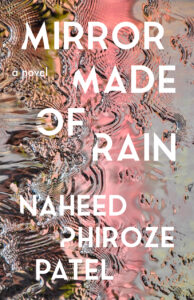
What Do Writing a Novel and Tending a Garden Have in Common?
Naheed Phiroze Patel on the Life-Long Projects of Writing and Gardening
It is March 2020 and sirens are screaming demons outside my apartment window. The nice old Russian lady in the elevator who’d greet me with her smoke-raspy stories and pat my kid’s head with her papery hands is dead. As are a handyman with several underlying conditions and a young, healthy person with none. I wear a mask but still hold my breath to toss my garbage bag into the hallway chute.
For a week, my neighbors’ garbage is set outside their door. I go back into our one bedroom apartment and crack open the windows as far as they’ll go (since we have a child under ten—the windows aren’t supposed to open more than a couple of inches) I imagine our neighbors as virus-emitting smoke machines, the kind they used in discos. I imagine the virus seeping in from under thin, hollow walls that separate our living rooms. At seven in the evening, I dutifully join the chorus of cheers for the essential workers, pushing my mouth through a sliver of open window, and feeling the cold spring air brush past my lips as I hoot and holler like a fool.
It is March 2020 and I have, miraculously, against all odds, an agent, and a novel out on submission. It feels like I’ve made it. For a moment, it feels like the publishing world has opened a side door, unhooked a velvet rope, and ushered me through. That is, until the rejections start to flutter to my inbox: “doesn’t hold together”; “more like a collection of set pieces”; “can’t get any narrative traction”. They’re feathered with a few douce phrases: “one of a kind”; “assured”; “tough decision”; “keep in mind for future submissions.” The sadness I feel for my novel is swallowed by my profound grief for the world we’re all losing together bit by bit, like animals watching their forest home cut down and taken away by big machines. I learn that even grief has an order to it, a hierarchy of heartaches.
Then, even the rejections stop, when refrigerator trucks park alongside hospitals’ streets and the East Meadow blooms white tents full of ventilators and beds. After twenty-eight days of staying inside, I take my daughter to Central Park. It is April. The trees are in full bloom. There is, to misquote Rilke, beauty and terror happening everywhere. People lie in the sunshine while sirens scream into the air. I pick up a stick; my daughter and I play games of hangman in the baseball diamond, scratching words into the wet orange sand.
The sadness I feel for my novel is swallowed by my profound grief for the world we’re all losing together bit by bit.
As an immigrant, the pandemic wraps concertina wire around the hope of ever seeing my home in India, or my grandmother, my father’s mother, again. A vivid childhood memory is of my grandmother on the veranda overlooking her garden, watching it for hours. After school, I’d go sit with her, and listen to her chatter pleasantly about all that had happened in the garden since the morning. How the mongoose had briefly come out to bask in the sun, how the white owl had flown off after its week-long sannyasa on the solitary coconut tree, how a small nest of baby squirrels had fallen to the grass where the dogs had killed and eaten them.
I imagine my grandmother as she was when our home was being built in the 1950s. Eighteen years old and pregnant, she cut a hole in her tight, high-waisted skirts for her belly and covered it with a long flowy blouse. I see her standing in her kitten heels, balancing her gravid weight on one hip, staring out at the tranche of brown dirt that would become her garden. My grandmother had little in the way of formal learning, not having studied past tenth grade. But what she did have was an eye towards beauty, and a desire to transform that plot of dirt into a living, growing work of art. Quietly and steadily, over the span of several decades, my grandmother brought what was inside her mind into existence—planting champa, areca palms, fan palms, crotons, ferns, galangals, hibiscus, mogra—training a violently pink bougainvillea to wrap about a Moringa tree like a shawl.
For me and my family, it is time for an inflection. A second migration. The house we find in the suburbs was built the year my grandmother was born and is by the train tracks in a small town with a white Gurudwara, a Sikh temple. These all seem like good omens. The house itself has a benign, matronly energy. Most of the doors don’t close all the way. The pine hardwood floors creak amiably; you always feel like you’re walking on a stage. There is a working fireplace. We close in June, and our realtor sticks around to take pictures of us below the Japanese Maple in the front yard, her high heels digging divots into the lawn. I used to love the city because I thought of myself as a people watcher. But I realize that I just enjoy watching—people, plants, animals. Noticing is a gateway drug to writing.
My novel is told from the sardonic point of view of a young woman, Noomi, who has spent her life fending off the scrutiny of wealthy, hypocritical socialites of a small, conservative town in India, who want to cast Noomi in the same mold as her angry, socially isolated, alcoholic mother. Taking place over decades of Noomi’s life, the novel charts her attempts to break free from a society which demands she perceive herself only through the eyes of others, and where conformity is often essential to survival. Framing the novel in terms of plot orthodoxies became more impossible the further I wrote into it, as Noomi’s voice was the only thing driving the narrative forward. The novel’s structure confounded me: the harder I tried to knit it together, the more easily it came undone.
T.S. Eliot has famously said, “Plot is the bone you throw the dog when you rob the house.” Western modes of storytelling, valorized and disseminated through writing programs in the US, encourage us to see a story’s organizing principle as embedded conflict—termed in MFA parlance as “the stakes.” But what if there was a different way to look at plot, in which action is non-hierarchal, and the entry points into a text are multiplicitous. The novels that held the most attraction for me were those in which the narrative impulse was not located in conflict but in the fractal energy of an ever-unfolding symmetry—such as in the branch and root systems of the Champa and Moringa trees in my grandmother’s garden—novels like Motherhood by Sheila Heti, The God of Small Things by Arundhati Roy, Avni Doshi’s Burnt Sugar, and A Ghost in the Throat by Doireann Ní Ghríofa.
The God of Small Things, told in a non-linear timeline, spirals outwards from the core of a beautiful, sensual scene of lovemaking between an upper caste woman, Ammu and a lower caste man, Velutha (Unmentionably taboo in India, this scene became the slim peg upon which Roy’s native state of Kerala hung an obscenity charge against the author, causing her to end her US tour and appear before a judicial magistrate).
In an interview, Roy said that her studies as an undergraduate in a New Delhi architectural college helped her figure out the plot of her novel: “In buildings, there are design motifs that occur again and again, that repeat—patterns, curves. These motifs help us feel comfortable in a physical space. And the same works in writing, I’ve found.”
A similar repetitive geometry appears at the heart of Sheila Heti’s Motherhood, where the author interrogates the moral and existential impetus of motherhood using a recursive technique inspired by the ancient, arcane divination system known as the I Ching. In Avni Doshi’s Burnt Sugar, unreliability of memory is the spine that holds together a sprawling nervous system of a novel about a woman’s anger towards her abusive mother. Doireann Ní Ghríofa’s coruscating A Ghost in The Throat is a remarkable hybrid work in which the author interleaves the life of a 19th-century woman poet, who composed a renowned Irish lament, a Caoineadh, with her narrator’s ruminations on art, obsession, motherhood and speaking into the void borne of the willful erasure of women’s voices from history.
By just showing up, by attending to the dirt, to the page, I could sow words and make them germinate.
For my own novel, I turned to observing and understanding homeostasis: the equilibrium between ongoing processes in a highly intricate and interconnected system—a state that balances on the fulcrum between constant decay and perpetual renewal. Time operates differently in the plant world. A hundred-year-old tree is barely a teenager in tree-years. There are fungi networks that are thousands of years old. Many of these years are spent strengthening and deepening root systems, with trees and fungi living symbiotically to create a network under the forest floor.
The social life of plants and trees—the ways a garden speaks to itself and about itself—taught me how to note the subtle subterranean interpolations between character, setting, action, point of view, conflict, etc., in a novel. Narrative elements need time to strengthen and coalesce together like roots and fungi before the story can finally bloom out. As I spent the summer and fall outdoors in the garden, and indoors on my novel, I noticed a welcome change in my creative anxiety. I expended less time and energy on authorial control, more on observing with a lightly held sense of curiosity.
By just showing up, by attending to the dirt, to the page, I could sow words and make them germinate. If they don’t grow into the story I’d envisioned, so be it. It’s been two years since we moved to the suburbs; my novel will publish with a wonderful, bold indie press, just in time for the bulbs I’d buried in the fall to grow into daffodils, hyacinths, and tulips that open wide to eat the sunshine.
A pair of cardinals live in the holly bushes in our backyard. A Norway spruce casts a ragged afternoon shadow. Owls nest in its balding crown, looking like the ghosts of poets. The spruce leans forward, its drooping branches stretch down like the arms of a parent reaching to pick up a child. Survival is the cost of longevity—a tree can’t grow old without being helped by colleagues who provide nutrients and information through the mycelium growing under their feet.
I’m grateful for the interconnectedness in the natural world remaining antipodal to the relentless selfhood we’re force-fed by capitalist systems—the ones that encourage us to ignore the weakest, most marginalized among us in pursuit of pleasure or comfort. That compels us to cheer emptily for essential workers while doing nothing to keep them safe like wearing a mask, staying at home, or getting a vaccine. Last summer, I watched from my patio as the cardinals taught one of their children how to fly; it felt like I’d been invited into their secret world.
In the evening, fireflies would rise from the grass like blinking thoughts. This new garden is a plot of dirt. I try to look at it through my grandmother’s eyes. Like her, I am starting on my life-long art project.
___________________________________

Mirror Made of Rain by Naheed Phiroze Patel is available from Unnamed Press.
Featured image courtesy of Naheed Phiroze Patel
Naheed Phiroze Patel
Naheed Phiroze Patel is a graduate of the MFA program at Columbia University’s School of the Arts. Her writing has appeared in the New England Review, The Guardian, HuffPost, Scroll.in, BOMB Magazine, Public Books, PEN America, The Rumpus, EuropeNow Journal, Asymptote Journal and elsewhere.



















